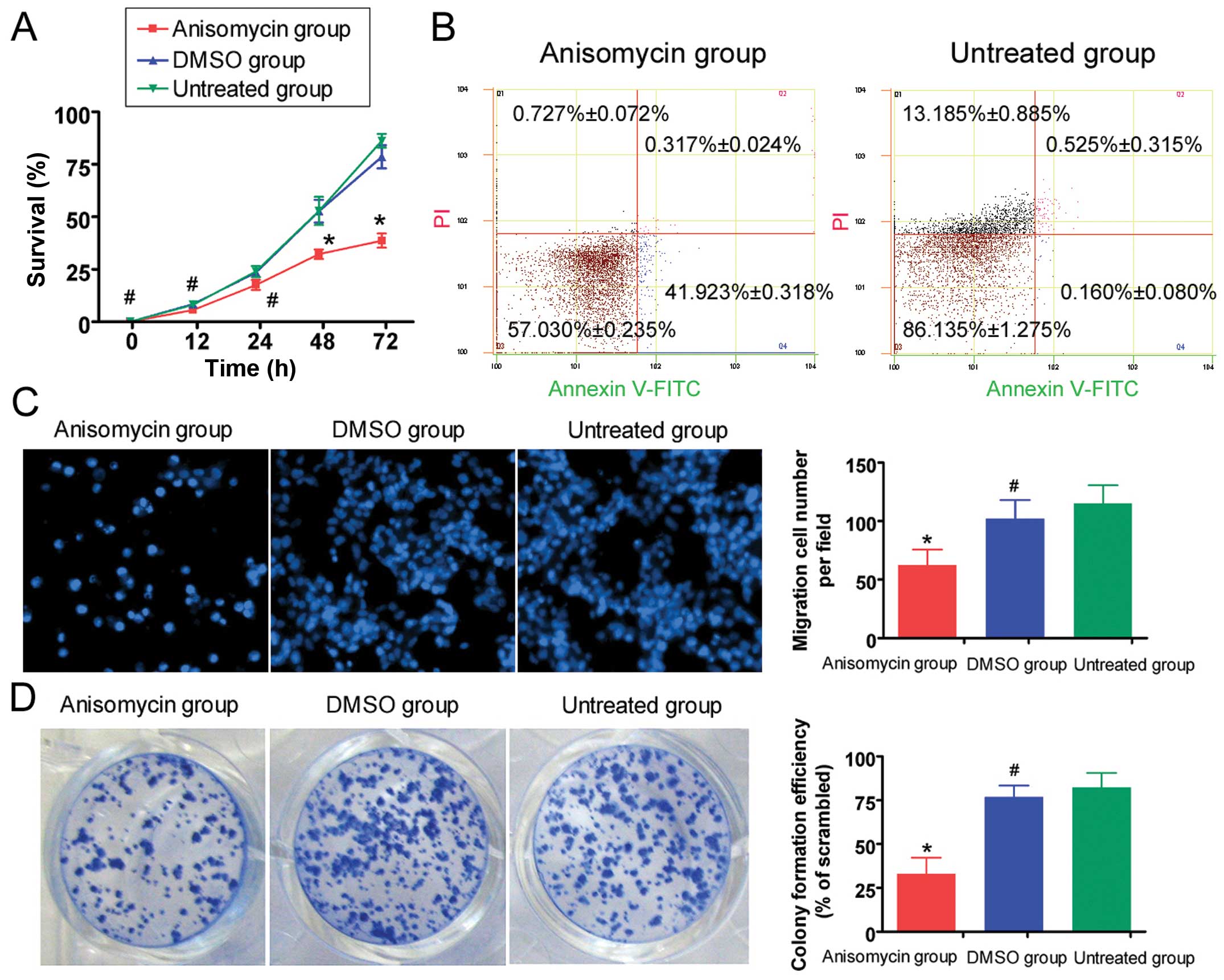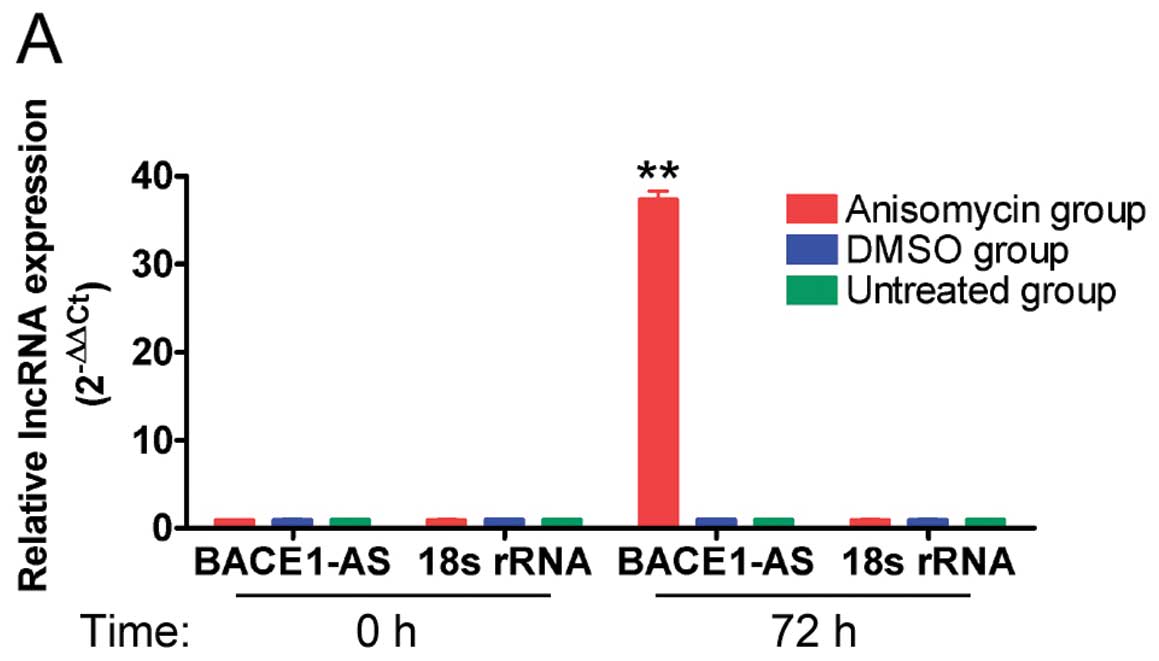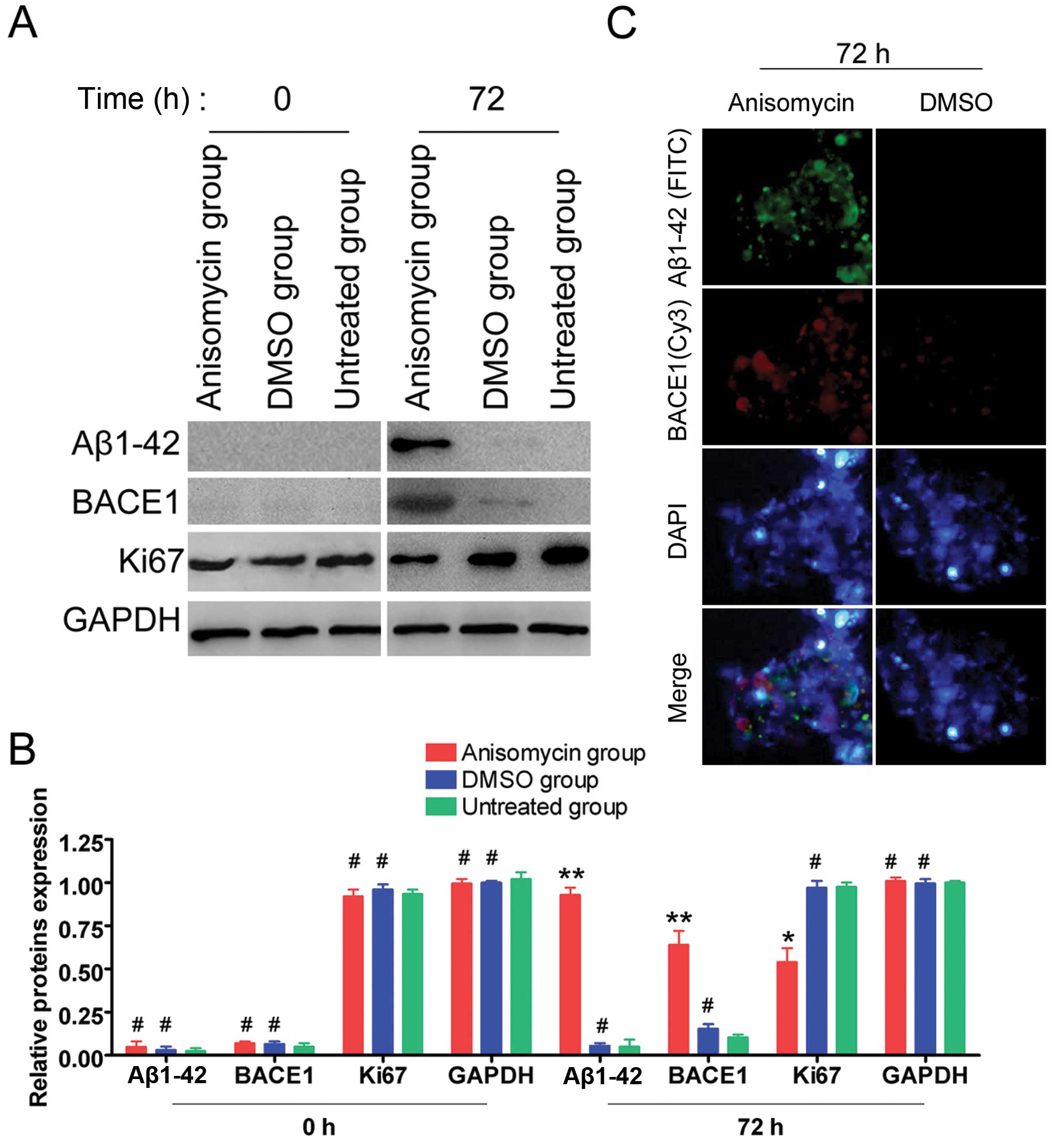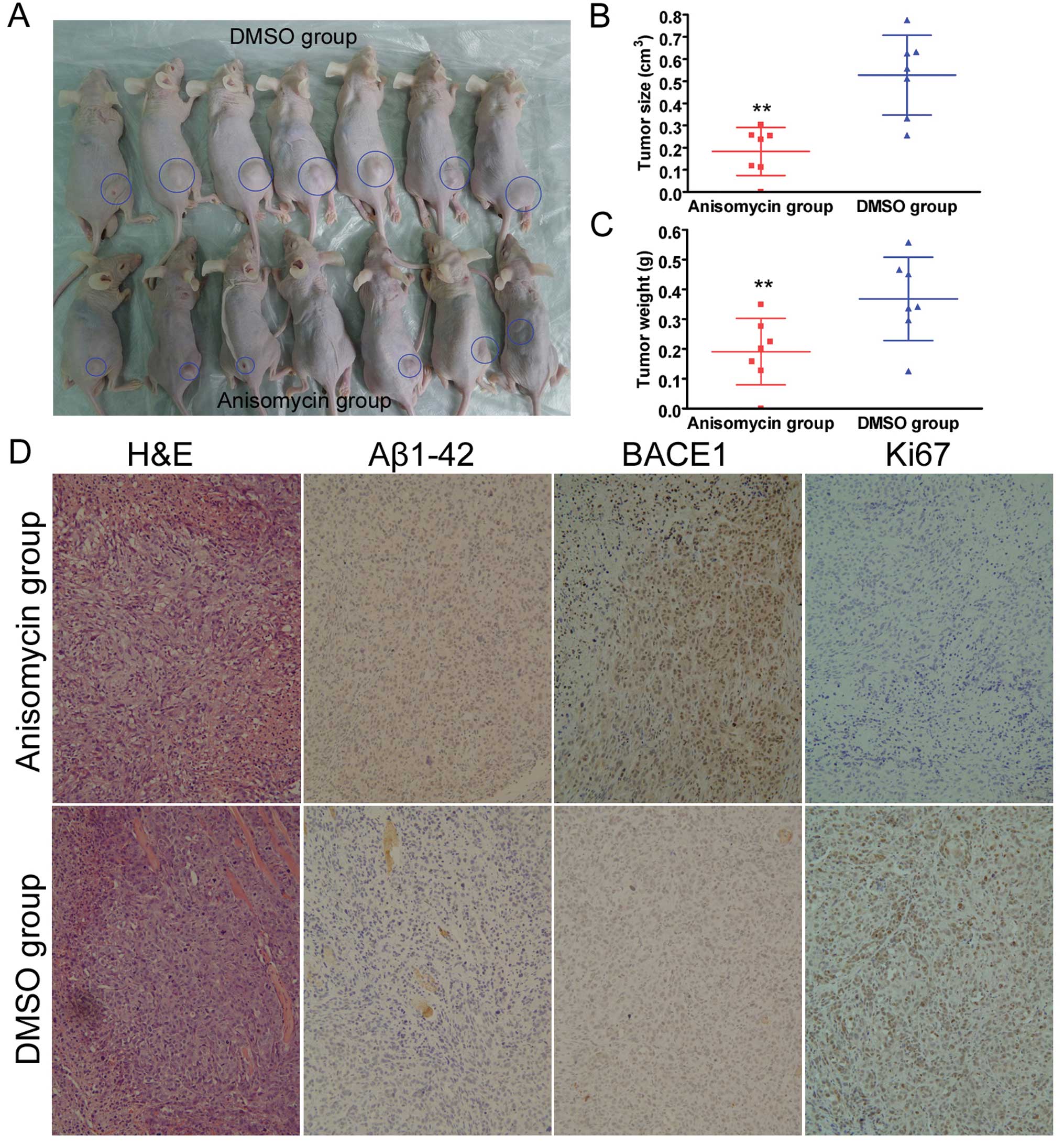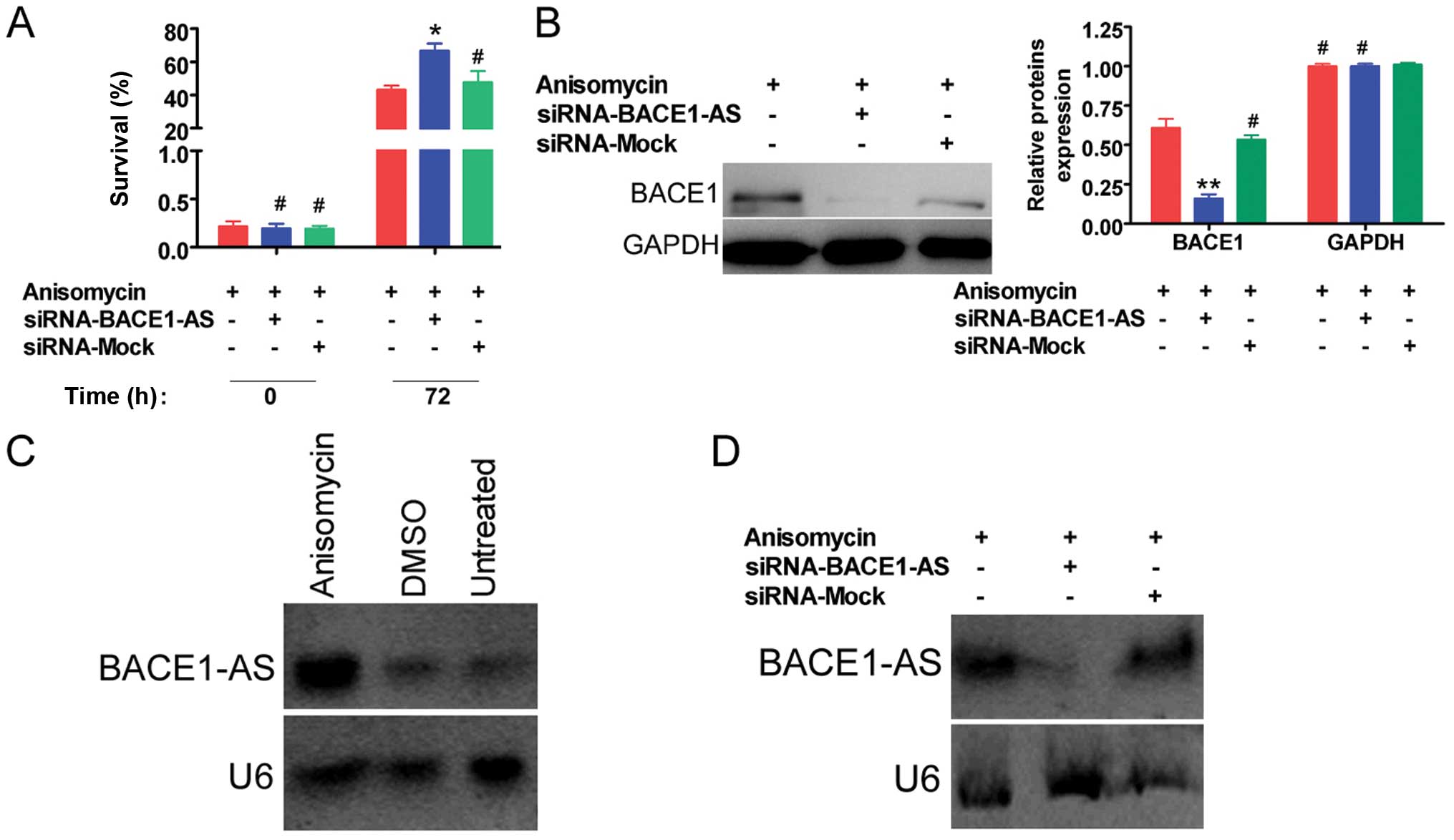Introduction
Human ovarian cancer stem cells (OCSCs) are one of
the main factors affecting ovarian cancer metastasis, recurrence,
prognosis and tolerance to chemotherapy drugs (1–9). To
date, there are no effective therapies to inhibit OCSC
proliferation or invasion. While the mechanisms of OCSC
proliferation and invasion remain unclear, recent studies suggest
that proteins involved in Alzheimer's disease etiology, including
the amyloid precursor protein (APP) and amyloid β (Aβ) peptides,
may be involved (10,11).
A recent study showed that inhibition of
microRNA-20a expression increases APP expression and suppresses
ovarian cancer cell proliferation and invasion (10). Similarly, other studies indicate
that anisomycin, a small molecule antibiotic, can inhibit the
proliferative and invasive ability of some tumor cells by
increasing the production of the toxic amyloid β (Aβ1-42) peptides
from APP (11,15–19).
In particular, anisomycin
[2-(p-methoxybenzyl)-3,4-pyrrolidinediol-3-acetate] increases mRNA
expression of APP, β-site APP cleaving enzyme 1 (BACE1 or
β-secretase) and presenilin 1 (PS1) in a human SH-SY5Y cell line
(10). In turn, APP influences cell
adhesion, motility and proliferation, and is renowned for its
ability to produce toxic Aβ1-42 peptides (11). Toxic Aβ1-42 peptides are generated
from the cleavage of APP by BACE1 and the γ-secretase complex
(which consists of PS1) (10). In
neuronal cells, Aβ1-42 destroys the integrity of the cell membrane
(10–14). However, few studies have
investigated the effects of APP and Aβ1-42 on tumor cell
proliferation, invasion and tumorigenesis.
Another important factor regulating Aβ1-42
production is the expression of the long non-coding RNA
BACE1-antisense transcript (lncRNA BACE1-AS), which is upregulated
in patients with Alzheimer's disease. The lncRNA can stabilize
BACE1 mRNA and generate additional BACE1 through a feed-forward
mechanism, thereby stimulating Aβ1-42 production (12,13).
However, whether lncRNA BASE1-AS increases Aβ1-42 production in
tumor cells treated with anisomycin remains unknown.
While anisomycin has been shown to have
antiproliferative ability in Jurkat T cells (16) and enhance apoptosis of various
cancer cell types [including renal carcinoma, glucocorticoid
resistant acute lymphoblastic leukemia and glioma cells (15)], the effects of anisomycin on human
OCSCs are not well studied. We hypothesized that anisomycin could
suppress human OCSC proliferation and invasion by stimulating
lncRNA BACE1-AS and upregulating Aβ1-42 expression. Using ovarian
cancer stem cells derived from seven ovarian cancer patients, we
analyzed the expression levels of lncRNA BACE1-AS, APP, Aβ1-42 and
apoptosis-related proteins after treatment with anisomycin. We also
investigated whether silencing of lncRNA BACE-1 expression using
siRNA would alter the anisomycin-related antiproliferative and
anti-invasive effects.
Materials and methods
Isolation of
CD44+/CD117+ ovarian cancer stem cells
All samples were collected from the inpatient clinic
of Shanghai Pudong New Area Gongli Hospital (Shanghai, China)
between June 2013 and December 2014. All human materials were
obtained according to consent regulation and approved by the Ethics
Review Committee of the World Health Organization of Collaborating
Center of Research in Human Production authorized by Shanghai
Municipal Government. Briefly, 4 µl of CD44+ and
CD117+ primary monoclonal antibodies (mouse anti-human
CD117-FITC, rabbit anti-human CD44-PE; eBioscience) at 1 mg/100 ml
were added to the primary ovarian cancer cell sediment to block
nonspecific binding, and the cells were stored at 4°C in
phosphate-buffered saline (PBS) for 30 min in a volume of 1 ml as
previously described (1,3,4,9). After
the reaction, the cells were washed twice in PBS. They were
isolated and enriched by flow cytometry (BD FACSAria; BD
Biosciences, San Jose, CA, USA), incubated at 10°C in PBS for 15
min before being washed twice in PBS. Single cells were plated at
1,000 cells/ml in Dulbecco's modified Eagle's medium (DMEM):F12
(HyClone), supplemented with 10 ng/ml basic fibroblast growth
factor (bFGF), 10 ng/ml epidermal growth factor (EGF), 5
µg/ml insulin and 0.5% bovine serum albumin (BSA) (all from
Sigma-Aldrich). All CD44+/CD117+ cells were
cultured in the above conditions as non-adherent spherical
clusters, termed ovarian carcinoma-initiating cells. All cells were
cultured under the same conditions until passage three, when they
were used for further experiments.
RNA extraction and analysis by
quantitative real-time PCR (qRT-PCR)
Total RNA from each cell was isolated using TRIzol
reagent (Invitrogen), according to the manufacturer's protocol. The
RNA samples were treated with DNase I (Sigma-Aldrich, St. Louis,
MO, USA), quantified and reverse-transcribed into cDNA using the
ReverTra Ace-α First Strand cDNA Synthesis kit (Toyobo).
Quantitative RT-PCR was conducted using a RealPlex4 real-time PCR
detection system from Eppendorf Co., Ltd. (Germany), with
SYBR-Green Real-Time PCR Master Mix (Toyobo) as the detection dye.
Amplification was performed over 40 cycles with denaturation at
95°C for 15 sec and annealing at 58°C for 45 sec. Target cDNA was
quantified using the relative quantification method. A comparative
threshold cycle (Ct) was used to determine gene expression relative
to a control (calibrator) and steady-state mRNA levels are reported
as an n-fold difference relative to the calibrator. For each
sample, the maker gene Ct value was normalized using the formula Ct
= Ct_genes-Ct_18sRNA. To determine relative expression levels, the
following formula was used: ΔΔCt = ΔCt_all_ groups-ΔCt_blank
control_group. The values used to plot relative expression of
markers was calculated using the expression 2−ΔΔCt. The
mRNA levels were calibrated based on levels of 18s rRNA. The cDNA
of each gene was amplified using primers as previously described
(12,13).
Northern blot analysis
Northern blotting experiments were performed as
previously described (7,13). For all samples, 20 µg of good
quality total RNA was analyzed on a 7.5 M urea 12% polyacrylamide
denaturing gel and transferred to a Hybond N+ nylon
membrane (Amersham, Freiburg, Germany). Membranes were cross-linked
using UV light for 30 sec at 1,200 mJ/cm2. Hybridization
was performed with the anti-sense starfire probe to be detected the
lncRNA BACE1-AS fragments according to the manufacturer's
instructions (12,13). After washing, membranes were exposed
for 20–40 h to Kodak XAR-5 film (Sigma-Aldrich). As a positive
control, all membranes were hybridized with a human U6 snRNA probe,
5′-GCAGGGGCCATGCTAATCTTCTCTGTATCG-3′. Exposure times for the U6
control probe varied between 15 and 30 min.
Methylthiazolyl tetrazolium (MTT) assay
for cell proliferation
Cells were seeded (2×103/well) in 96-well
plates and cultured in DMEM supplemented with 10% fetal bovine
serum (FBS) at 37°C with 5% CO2, until 85% confluent.
3-(4,5-Dimethylthiazol-2-yl)-2,5-diphenyltetrazolium bromide (MTT);
Sigma Chemicals reagent (5 mg/ml) was added to the maintenance cell
medium at different time points, and incubated at 37°C for an
additional 4 h. The reaction was terminated with the addition of
150 µl dimethylsulfoxide (DMSO; Sigma Chemicals) per well.
Cells were lysed for 15 min, and the plates were gently shaken for
5 min. Absorbance values were determined using the enzyme-linked
immunosorbent assay (ELISA) reader (Model 680; Bio-Rad) at 490
nm.
Western blot analysis
Total protein extracts were resolved by 12% SDS-PAGE
and transferred on polyvinylidene difluoride (PVDF) membranes
(Millipore). After blocking, the PVDF membranes were washed four
times for 15 min with Tris-buffered saline with Tween-20 (TBST) at
room temperature and incubated with primary antibody (Table I). Following extensive washing,
membranes were incubated with secondary peroxidase-linked goat
anti-rabbit IgG (1:1,000; Santa Cruz Biotechnology) for 1 h. After
washing four times for 15 min with TBST at room temperature, the
immunoreactivity was visualized by enhanced chemiluminescence (ECL
kit; Pierce Biotechnology), and membranes were exposed to Kodak
XAR-5 film.
 | Table IThe source and dilutions of primary
antibodies. |
Table I
The source and dilutions of primary
antibodies.
| Antibodies | Companies | Applications |
|---|
| Rabbit anti-human
Aβ1-42 | Cell Signaling
Technology, Danvers, MA, USA | WB
(1:1,000)
ICH (1:100) |
| Goat anti-human
BACE1 | Santa Cruz
Biotechnology, Santa Cruz, CA, USA | WB
(1:1,000)
ICH (1:100) |
| Rabbit anti-human
Ki67 | Santa Cruz
Biotechnology, Santa Cruz, CA, USA | WB
(1:1,000)
ICH (1:100) |
| Rabbit anti-human
GAPDH | Cell Signaling
Technology, Danvers, MA, USA | WB (1:1,000) |
| Donkey
anti-goat-Cy3 | Santa Cruz
Biotechnology, Santa Cruz, CA, USA | IF (1:100) |
| Goat
anti-rabbit-FITC | Santa Cruz
Biotechnology, Santa Cruz, CA, USA | IF (1:100) |
Soft agar colony formation assay
All steps were performed as previously described in
6-well plates (7). The base layer
of each well consisted of 2 ml with final concentrations of 1X
media (DMEM+10% FBS) and 0.6% low melting point agarose. Plates
were chilled at 4°C until solid and then a 1 ml growth layer of
agar was poured, consisting of 1×104 cells suspended in
1X media and 0.3% low melting point agarose. Plates were again
chilled at 4°C until the growth layer congealed. An additional 1 ml
of 1X media without agarose was added on top of the growth layer on
day 0 and again on day 15 of growth. Cells were allowed to grow at
37°C for 1 month and then the total number of colonies was counted.
Assays were repeated three times. Results were statistically
analyzed by paired t-test using the GraphPad Prism program.
Transwell migration assay
All steps were performed as previously described
(1). Briefly, cells
(2×105) were resuspended in 200 µl of serum-free
medium and seeded on the top chamber of the 8.0-µm pore, 6.5
mm polycarbonate Transwell filters (Corning). A total of 600
µl of DMEM+10% FBS was added to the bottom chamber. The
cells were allowed to migrate for 24 h at 37°C in a humidified
incubator with 5% CO2. The cells attached to the lower
surface of the membrane were fixed in 4% paraformaldehyde at room
temperature for 30 min and stained with
4,6-diamidino-2-phenylindole (DAPI) (C1002; Beyotime Institute of
Biotechnology, China). The number of cells on the lower surface of
the filters was counted under the microscope. A total of five
fields were counted for each Transwell filter.
Annexin V-FITC/PI staining and flow
cytometric analysis
Apoptosis was evaluated using an Annexin V-FITC/PI
staining kit (Beyotime Institute of Biotechnology) according to the
manufacturer's instructions and as previously described (16). Briefly, cells were seeded
(3×105/well) in 6-well plates and cultured until 85%
confluent. Cells were washed with PBS three times, and collected by
centrifugation (Allegra X-22R; Beckman Coulter) at 1,000 × g for 5
min. The cell pellets were resuspended in 0.1 ml of PBS, stained
with the Annexin V-FITC/PI kit, incubated for 30 min at 4°C and
analyzed using a fluorescence-activated cell sorting (FACS) machine
(BD FACSAria). A total of 20,000 events were acquired for analysis
using CellQuest software.
Immunofluorescence (IF) staining
The cultured cells were washed three times with PBS
and fixed with 4% paraformaldehyde (Sigma-Aldrich) for 30 min.
After blocking, the cells were incubated first with primary
antibody (Table I) overnight at
4°C, and then with FITC-conjugated goat anti-rabbit IgG antibody
(1:200; Abcam, Cambridge, UK) and 5 µg/ml DAPI
(Sigma-Aldrich) at room temperature for 30 min. Cells were
thoroughly washed with TBST and viewed through a fluorescence
microscope (DMI3000; Leica, Allendale, NJ, USA).
In vivo xenograft experiments
OCSCs were divided into two groups: a negative
control group (OCSCs pretreated with DMSO), which were treated with
DMSO for 72 h; and an experimental group (OCSCs pretreated with
anisomycin), which were treated with anisomycin (at its half
maximal inhibitory concentration, IC50=8.5 µmol)
for 72 h. Approximately 1×105 logarithmically growing
OCSCs were inoculated in BALB/c nude, or nude mice. Each
experimental group consisted of seven mice. After seven weeks of
observation, the mice were sacrificed and tumors were stripped
(7,8). Tumor weight was measured and tumor
volume was calculated according to the formula: Tumor volume
(mm3) = (ab2)/2, where a, represents the
longest axis (mm) and b, the shortest axis (mm).
Statistical analysis
Each experiment was performed as least three times
and data are shown as the mean ± SE where applicable. Differences
were evaluated using Mann-Whitney test. The probability p<0.05
was considered to indicate a statistically significant result.
Results
Patient population filter
We examined a total of seven ovarian cancer patients
with undifferentiated and mixed epithelial ovarian carcinoma. The
characteristics of all ovarian patients are summarized in Table II. The age, stage, grade of
differentiation and histology distribution of the patient
populations were released by the International Federation of
Gynaecology and Obstetrics (FIGO) annual report for European
countries (1,7).
 | Table IICharacteristics of the patients
cohort. |
Table II
Characteristics of the patients
cohort.
|
Characteristics | Patients (n=7) |
|---|
| Age median
(range) | 38–62 |
| ≤40 | 2 |
| 40–60 | 4 |
| ≥60 | 1 |
| Surgical
staging | |
| I a–c | 1 |
| II a–c | 3 |
| III a–c | 3 |
| IV | – |
| Histopathology | |
| Serous | – |
| Endometrioid | – |
| Mucinous | – |
| Clear cells | – |
| Others (mixed
epithelial, undifferentiated) | 7 |
| Tumor grade | |
| 1 | 1 |
| 2 | 4 |
| 3 or clear
cell | 2 |
| Unknown | – |
| Treatments | |
| Primary
surgery | 7 |
| Radical
surgery | – |
| Secondary
surgery | – |
| Platinum-based
chemotherapy | 5 |
| Radiotherapy | – |
Anisomycin suppresses OCSC proliferation
and invasion
Cell viability (MTT) assays revealed no significant
difference in the viability of anisomycin (8.5 µmol) treated
OCSCs compared to controls in the first 24 h of treatment (i.e., at
0, 12 and 24 h; Fig. 1A). However,
over time (48–72 h), anisomycin-treated OCSCs showed a significant
decrease in cell proliferation compared to the DMSO treated and
untreated group (Fig. 1A). After 72
h of treatment, there was a significant increase in the percentage
of cells undergoing early apoptosis (Annexin
V-FITC+/PI−) in the anisomycin-treated OCSCs
compared to the untreated OCSCs (Fig.
1B). Moreover, there were significantly fewer invading
aniso-mycin-treated OCSCs/well (migration cell number, 63±13) than
DMSO-treated OCSCs/well (102±16) or untreated OCSCs/well (115±15)
(Fig. 1C). After 72 h of treatment,
there were substantially fewer colonies in the anisomycin-treated
OCSC agar plate (33.01±9.17%) when plated at low density compared
to the DMSO-treated OCSC plate (76.71±6.26%) or the untreated OCSC
plate (82.26±8.32%) (Fig. 1D).
These results suggest that anisomycin suppresses OCSC proliferation
and invasion.
Anisomycin stimulates expression of
lncRNA BACE1-AS and apoptosis-related proteins in OCSCs
Our qRT-PCR analysis showed that the expression of
lncRNA BACE1-AS in the anisomycin-treated OCSCs was significantly
elevated compared to the DMSO treated OCSCs or untreated OCSCs
after 72 h (Fig. 2A). In addition,
the expression of BACE1, APP, Bcl2 and Bax mRNAs in the anisomycin
treated OCSCs was elevated compared to the DMSO treated OCSCs or
untreated OCSCs after 72 h (Fig.
2B). Expression of the Ki67 (a cellular marker for
proliferation) mRNA in the anisomycin treated OCSCs was decreased
compared the DMSO treated or untreated OCSCs (Fig. 2B).
In terms of protein expression, our western blot
analysis confirmed that expression of amyloid-β-related proteins
(BACE1 and Aβ1-42) were significantly increased in the anisomycin
treated OCSCs compared to the DMSO treated or untreated OCSCs after
72 h (Fig. 3A and B). However, the
expression of the Ki67 protein was significantly decreased in the
anisomycin treated OCSCs compared the DMSO treated or untreated
OCSCs (Fig. 3A and B).
Additionally, IF staining confirmed that BACE1 and Aβ1-42 levels
increased in the anisomycin treated OCSCs compared the DMSO treated
or untreated OCSCs after 72 h (Fig.
3C). These data indicate that anisomycin induces lncRNA
BACE1-AS expression and expression of amyloid-β-related
proteins.
Anisomycin inhibits OCSCs xenograft
growth
All mice inoculated with anisomycin or DMSO
pretreated OCSCs developed tumors ~7 weeks after injection.
Although both experimental groups eventually developed tumors,
tumors formed by anisomycin pretreated OCSCs grew more slowly than
those derived from DMSO pretreated OCSCs (Fig. 4A). Furthermore, when mice were
sacrificed seven weeks after inoculation with OCSCs, tumors
obtained from the anisomycin pretreated group were significantly
smaller and lighter than those from the DMSO pretreated group
(Fig. 4B and C). Representative
hematoxylin and eosin-stained sections of all subcutaneous
xenograft tumors were categorized as mixed epithelial ovarian
carcinoma of moderate or poor differentiation (grade II/III)
(Fig. 4D). Furthermore,
immu-nohistochemical staining indicated that expression of the
BACE1 and Aβ1-42 proteins were significantly higher in tumors
derived from anisomycin pretreated OCSCs compared to those derived
from the DMSO pretreated OCSCs (Fig.
4D). The expression of the Ki67 protein was significantly
decreased in the anisomycin pretreated OCSCs compared to the DMSO
pretreated OCSCs (Fig. 4D). Thus,
xenografts formed by anisomycin pretreated OCSCs were smaller and
experienced reduced proliferation compared to those formed by DMSO
pretreated OCSCs.
siRNA targeting lncRNA BACE1-AS weakens
the effects of anisomycin on OCSC inhibition
To evaluate whether anisomycin regulates
proliferation and invasion of OCSCs by inhibiting lncRNA BACE1-AS
expression, we used a siRNA targeting BACE1-AS. OCSCs were
transfected with either siRNA-BACE1-AS or siRNA-Mock and then
treated with anisomycin for 72 h. The MTT assay indicated that the
survival ratio of the anisomycin treated siRNA-BACE1-AS transfected
OCSCs group was significantly higher than the anisomycin treated
siRNA-Mock transfected OCSCs group or the anisomycin treated
control group (Fig. 5A). Moreover,
western blot analysis showed that BACE1 protein expression was
significantly lower in the anisomycin treated siRNA-BACE1-AS
transfected OCSC group compared to the anisomycin treated
siRNA-Mock transfected OCSC group or the anisomycin treated control
group (Fig. 5B). Finally, northern
blot analysis revealed that the hybridization signal of lncRNA
BACE1-AS from the anisomycin treated OCSCs after 72 h was
signifi-cantly stronger than from the DMSO treated or untreated
OCSCs (Fig. 5C); but the
hybridization signal of lncRNA BACE1-AS from the anisomycin treated
siRNA-BACE1-AS transfected OCSC group was significantly lower than
in the anisomycin treated siRNA-Mock transfected OCSC group or the
anisomycin treated control group (Fig.
5D). These results indicate that silencing of lncRNA BACE1-AS
expression can weaken the effects of anisomycin in OCSCs.
Discussion
Anisomycin is a small molecule that has previously
shown efficacy in inhibiting proliferation of a variety of tumor
cells. In the present study, we found anisomycin (at
IC50 dose of 8.5 µM) inhibited the proliferation,
invasion and tumorigenesis of OCSCs. We found that anisomycin
increased the endogenous concentration of Aβ1-42 and expression of
BACE1 by elevating lncRNA BACE1-AS expression in OCSCs derived from
human ovarian cancer patients.
Similar to our results, previous studies have shown
that anisomycin can upregulate APP, BACE1 and PS1 expression by
reducing methyltransferase activity in SH-SY5Y cells (11). Yu et al also showed that
anisomycin suppresses Jurkat T cell proliferation by stimulating
P53/P21/P27 signaling and arresting cells at the S or G2/M phases
(17). Anisomycin was shown to
enhance apoptosis of renal carcinoma cells by down-regulating
proteins involved in apoptosis, i.e., Bcl-2, c-FLIP (L) and Mcl-1
(18). Liu et al indicated
that anisomycin induces apoptosis of glucocorticoid resistant acute
lymphoblastic leukemia cells via activation of phosphorylating
mitogen-activated protein kinases p38 and Jun N-terminal kinase
(15). Finally, anisomycin was
shown to induce glioma cell death by downregulating the protein
phosphatase 2A catalytic subunit in vitro (19). While our results are similar to
previous findings and confirm the antiproliferative and
anti-invasive ability of anisomycin, here we identified lncRNA
BACE1-AS as a novel mechanism.
We propose that anisomycin increases lncRNA BACE1-AS
expression, which in turn, stabilizes BACE1 mRNA and increases
BACE1 expression through a feed-forward mechanism. As BACE1 is
crucial for APP processing and Aβ1-42 production, which are toxic
to cells, anisomycin could therefore result in OCSC apoptosis
(11,14,20–25).
Indeed, our previous studies and others indicate that lncRNA
BACE1-AS forms RNA duplexes and increased the stability of BACE1
mRNA, thereby attenuating Aβ1-42 production (12,13).
To prove that anisomycin targets lncRNA BACE1-AS, we used siRNA
against BACE1-AS and showed that when OCSCs were transfected with
siRNA-BACE1-AS and treated with anisomycin, cell toxicity was
reduced compared to controls. Thus, silencing of lncRNA BACE1-AS
weakens the effects of anisomycin in OCSCs, which confirms that
lncRNA BACE1-AS is targeted by anisomycin.
We also found that xenografts formed by anisomycin
pretreated OCSCs were smaller and experienced reduced proliferation
compared to those formed by DMSO pretreated OCSCs. This suggests
that increasing lncRNA BACE1-AS expression (e.g., with anisomycin)
is a novel strategy for reducing OCSC proliferation and invasion,
and holds potential for future ovarian cancer treatment.
In conclusion, we showed that anisomycin suppresses
proliferation and invasion of human OCSCs by increasing lncRNA
BACE1-AS levels. In turn, lncRNA BACE1-AS can increase BACE1 mRNA
stability, enhance APP processing, and elevate levels of the Aβ1-42
peptide, which are toxic to tumor cells. Therefore, our results
suggest a novel mechanism for the antiproliferative or
anti-invasive activity of anisomycin, and indicate that targeting
lncRNA BACE1-AS expression could be a potential treatment for
ovarian cancer.
Acknowledgments
The present study was supported by grant from the
National Natural Science Foundation of China (no. 81202811), the
Project funded by China Postdoctoral Science Foundation (nos.
2014M550250 and 2015T80455), the Shanghai Municipal Health Bureau
Fund (no. 20124320), the Key Discipline Construction Project of
Pudong Health Bureau of Shanghai (WZx2014-03), and Discipline
Leader Project of Pudong Bureau of Shanghai (PWRd2014-02), and the
Shanghai Pudong District Science and Technology Innovation Project
(no. PKJ2015-Y52).
References
|
1
|
Cheng W, Liu T, Wan X, Gao Y and Wang H:
MicroRNA-199a targets CD44 to suppress the tumorigenicity and
multidrug resistance of ovarian cancer-initiating cells. FEBS J.
279:2047–2059. 2012. View Article : Google Scholar : PubMed/NCBI
|
|
2
|
Høgdall E, Fung ET, Christensen IJ, Yip C,
Nedergaard L, Engelholm SA, Risum S, Petri AL, Lundvall L, Lomas L,
et al: Proteomic biomarkers for overall and progression-free
survival in ovarian cancer patients. Proteomics Clin Appl.
4:940–952. 2010. View Article : Google Scholar : PubMed/NCBI
|
|
3
|
Liu T, Cheng W, Lai D, Huang Y and Guo L:
Characterization of primary ovarian cancer cells in different
culture systems. Oncol Rep. 23:1277–1284. 2010.PubMed/NCBI
|
|
4
|
Liu T, Hou L and Huang Y: EZH2-specific
microRNA-98 inhibits human ovarian cancer stem cell proliferation
via regulating the pRb-E2F pathway. Tumour Biol. 35:7239–7247.
2014. View Article : Google Scholar : PubMed/NCBI
|
|
5
|
Liu T, Qin W, Hou L and Huang Y:
MicroRNA-17 promotes normal ovarian cancer cells to cancer stem
cells development via suppression of the LKB1-p53-p21/WAF1 pathway.
Tumour Biol. 36:1881–1893. 2015. View Article : Google Scholar
|
|
6
|
Ma L, Lai D, Liu T, Cheng W and Guo L:
Cancer stem-like cells can be isolated with drug selection in human
ovarian cancer cell line SKOV3. Acta Biochim Biophys Sin.
42:593–602. 2010. View Article : Google Scholar : PubMed/NCBI
|
|
7
|
Qin W, Ren Q, Liu T, Huang Y and Wang J:
MicroRNA-155 is a novel suppressor of ovarian cancer-initiating
cells that targets CLDN1. FEBS Lett. 587:1434–1439. 2013.
View Article : Google Scholar : PubMed/NCBI
|
|
8
|
Yu ZH, Liu T, Zhao YH, Huang YY and Gao
YT: Cisplatin targets the stromal cell-derived factor-1-CXC
chemokine receptor type 4 axis to suppress metastasis and invasion
of ovarian cancer-initiating cells. Tumour Biol. 35:4637–4644.
2014. View Article : Google Scholar : PubMed/NCBI
|
|
9
|
Zhang S, Balch C, Chan MW, Lai HC, Matei
D, Schilder JM, Yan PS, Huang TH and Nephew KP: Identification and
characterization of ovarian cancer-initiating cells from primary
human tumors. Cancer Res. 68:4311–4320. 2008. View Article : Google Scholar : PubMed/NCBI
|
|
10
|
Guo X, Wu X, Ren L, Liu G and Li L:
Epigenetic mechanisms of amyloid-β production in anisomycin-treated
SH-SY5Y cells. Neuroscience. 194:272–281. 2011. View Article : Google Scholar : PubMed/NCBI
|
|
11
|
Fan X, Liu Y, Jiang J, Ma Z, Wu H, Liu T,
Liu M and Lixand Tang H: miR-20a promotes proliferation and
invasion by targeting APP in human ovarian cancer cells. Acta
Biochim Biophys Sin. 42:318–324. 2010. View Article : Google Scholar : PubMed/NCBI
|
|
12
|
Faghihi MA, Modarresi F, Khalil AM, Wood
DE, Sahagan BG, Morgan TE, Finch CE, St Laurent G III, Kenny PJ and
Wahlestedt C: Expression of a noncoding RNA is elevated in
Alzheimer's disease and drives rapid feed-forward regulation of
beta-secretase. Nat Med. 14:723–730. 2008. View Article : Google Scholar : PubMed/NCBI
|
|
13
|
Liu T, Huang Y, Chen J, Chi H, Yu Z, Wang
J and Chen C: Attenuated ability of BACE1 to cleave the amyloid
precursor protein via silencing long noncoding RNA BACE1-AS
expression. Mol Med Rep. 10:1275–1281. 2014.PubMed/NCBI
|
|
14
|
Yan R and Vassar R: Targeting the β
secretase BACE1 for Alzheimer's disease therapy. Lancet Neurol.
13:319–329. 2014. View Article : Google Scholar : PubMed/NCBI
|
|
15
|
Liu Y, Ge J, Li Q, Gu L, Guo X, Ma ZG and
Zhu YP: Anisomycin induces apoptosis of glucocorticoid resistant
acute lymphoblastic leukemia CEM-C1 cells via activation of
mitogen-activated protein kinases p38 and JNK. Neoplasma.
60:101–110. 2013. View Article : Google Scholar
|
|
16
|
Feng Y, Liu T, Li XQ, Liu Y, Zhu XY,
Jankovic J, Pan TH and Wu YC: Neuroprotection by Orexin-A via
HIF-1α induction in a cellular model of Parkinson's disease.
Neurosci Lett. 579:35–40. 2014. View Article : Google Scholar : PubMed/NCBI
|
|
17
|
Yu C, Xing F, Tang Z, Bronner C, Lu X, Di
J, Zeng S and Liu J: Anisomycin suppresses Jurkat T cell growth by
the cell cycle-regulating proteins. Pharmacol Rep. 65:435–444.
2013. View Article : Google Scholar : PubMed/NCBI
|
|
18
|
Seo BR, Min KJ, Kim S, Park JW, Park WK,
Lee TJ and Kwon TK: Anisomycin treatment enhances TRAIL-mediated
apoptosis in renal carcinoma cells through the down-regulation of
Bcl-2, c-FLIP(L) and Mcl-1. Biochimie. 95:858–865. 2013. View Article : Google Scholar
|
|
19
|
Li JY, Huang JY, Li M, Zhang H, Xing B,
Chen G, Wei D, Gu PY and Hu WX: Anisomycin induces glioma cell
death via down-regulation of PP2A catalytic subunit in vitro. Acta
Pharmacol Sin. 33:935–940. 2012. View Article : Google Scholar : PubMed/NCBI
|
|
20
|
Hébert SS, Serneels L, Tolia A,
Craessaerts K, Derks C, Filippov MA, Müller U and De Strooper B:
Regulated intramembrane proteolysis of amyloid precursor protein
and regulation of expression of putative target genes. EMBO Rep.
7:739–745. 2006. View Article : Google Scholar : PubMed/NCBI
|
|
21
|
Laird FM, Cai H, Savonenko AV, Farah MH,
He K, Melnikova T, Wen H, Chiang HC, Xu G, Koliatsos VE, et al:
BACE1, a major determinant of selective vulnerability of the brain
to amyloid-beta amyloidogenesis, is essential for cognitive,
emotional, and synaptic functions. J Neurosci. 25:11693–11709.
2005. View Article : Google Scholar : PubMed/NCBI
|
|
22
|
Ohno M, Sametsky EA, Younkin LH, Oakley H,
Younkin SG, Citron M, Vassar R and Disterhoft JF: BACE1 deficiency
rescues memory deficits and cholinergic dysfunction in a mouse
model of Alzheimer's disease. Neuron. 41:27–33. 2004. View Article : Google Scholar : PubMed/NCBI
|
|
23
|
Luo Y, Bolon B, Damore MA, Fitzpatrick D,
Liu H, Zhang J, Yan Q, Vassar R and Citron M: BACE1
(beta-secretase) knockout mice do not acquire compensatory gene
expression changes or develop neural lesions over time. Neurobiol
Dis. 14:81–88. 2003. View Article : Google Scholar : PubMed/NCBI
|
|
24
|
Dominguez D, Tournoy J, Hartmann D, Huth
T, Cryns K, Deforce S, Serneels L, Camacho IE, Marjaux E,
Craessaerts K, et al: Phenotypic and biochemical analyses of BACE1-
and BACE2-deficient mice. J Biol Chem. 280:30797–30806. 2005.
View Article : Google Scholar : PubMed/NCBI
|
|
25
|
Luo Y, Bolon B, Kahn S, Bennett BD,
Babu-Khan S, Denis P, Fan W, Kha H, Zhang J, Gong Y, et al: Mice
deficient in BACE1, the Alzheimer's beta-secretase, have normal
phenotype and abolished beta-amyloid generation. Nat Neurosci.
4:231–232. 2001. View
Article : Google Scholar : PubMed/NCBI
|















